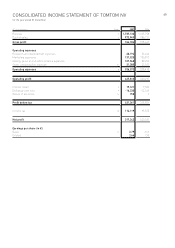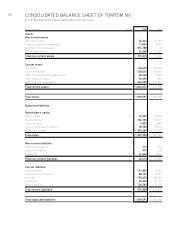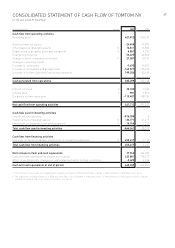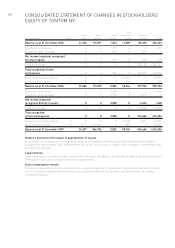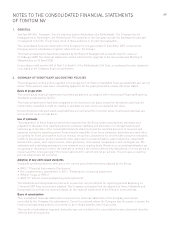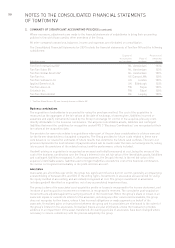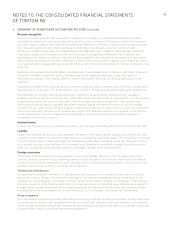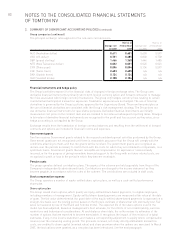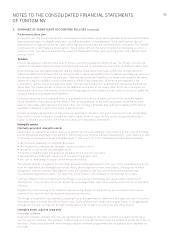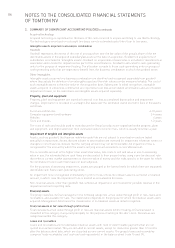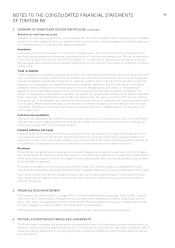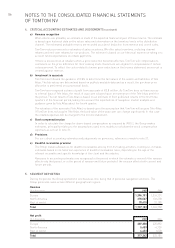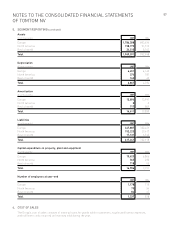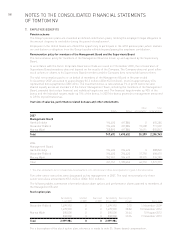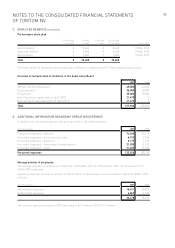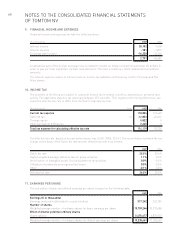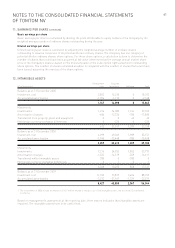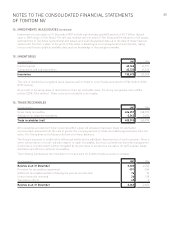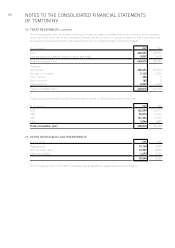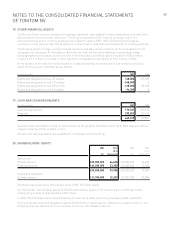TomTom 2007 Annual Report Download - page 61
Download and view the complete annual report
Please find page 61 of the 2007 TomTom annual report below. You can navigate through the pages in the report by either clicking on the pages listed below, or by using the keyword search tool below to find specific information within the annual report.
55
NOTES TO THE CONSOLIDATED FINANCIAL STATEMENTS
OF TOMTOM NV
2. SUMMARY OF SIGNIFICANT ACCOUNTING POLICIES (continued)
Available-for-sale financial assets
Available-for-sale financial assets are non-derivatives that are either designated in this category or not classified
in any of the other categories. They are included in non-current assets, unless management intends to dispose of
the investment within 12 months of the balance sheet date.
Inventories
Inventories are stated at the lower of cost and net realisable value. The cost of inventories comprises costs of
purchase, and assembly and conversion to finished products. It excludes borrowing costs. The cost of inventories
is recorded using the first-in first-out (FIFO) cost basis, net of reserves for obsolescence and any excess stock.
Net realisable value represents the estimated selling price less an estimate of the costs of completion and direct
selling costs.
Trade receivables
Trade receivables are initially recognised at fair value, and subsequently measured at amortised costs (if the time
value is material), using the effective interest method, less provision for impairment. A provision for impairment
of trade receivables is established when there is objective evidence that the Group will not be able to collect all
amounts due, according to the original terms of the receivables. Significant financial difficulties of the debtor,
probability that the debtor will enter bankruptcy or financial reorganisation, and default or delinquency in
payments (more than 30 days overdue) are considered indicators that the trade receivable is impaired. The
amount of the provision is the difference between the asset’s carrying amount and the present value of estimated
futurecash flows, discounted at the original effective interest rate. The carrying amount of the asset is reduced
through the use of an allowance account and the amount of the loss is recognised in the income statement within
‘costof sales’. When a trade receivable is uncollectible, it is written off against the allowance account for trade
receivables. Subsequent recoveries of amounts previously written off are credited against ‘cost of sales’ in the
income statement.
Cash and cash equivalents
Cash and cash equivalents are stated at face value and comprise cash on hand, deposits held on call with banks,
and other short-term highly liquid investments that are readily convertible to a known amount of cash and are
subject toan insignificant risk of changes in value.
Financial liabilities and equity
Financial liabilities and equity instruments issued by the Group are classified according to the substance of the
contractual arrangements entered into, and the definitions of a financial liability and an equity instrument. An
equity instrument is any contract that evidences a residual interest in the assets of the Group after deducting all
of its liabilities. Equity instruments are recorded at the proceeds received, net of direct issue costs.
Provisions
Provisions are recognised when the Group has a present obligation as a result of a past event and it is probable
that the Group will be required to settle that obligation. Provisions are measured at management’s best estimate
of the expenditure required to settle the obligation at the balance sheet date, and are discounted to present value
where the effect is material.
Provisions for warranty costs are recognised at the date of sale of the relevant products, at management’s best
estimate of the expenditure required to settle the Group’s obligation. Warranty costs are recorded within cost of sales.
Other provisions are recorded for probable liabilities that can be reasonably estimated. The provisions include
legal claims and tax risks for which it is more likely than not that an outflow of resources will be required to
settle the obligation.
3. FINANCIAL RISK MANAGEMENT
The businessrisk report included on pages 38-41, contains auditableparts comprising ‘Trade Credit’, ‘Liquidity’,
‘Currencies’ and ‘Interest Rates’. Management policies have been established to identify, analyse and monitor
these risks, and to set appropriate risk limits and controls. Risk management policies are reviewed periodically
to reflect changes in market conditions and the activities of the business.
Further quantitative disclosures are included throughout these consolidated financial statements.
4. CRITICAL ACCOUNTING ESTIMATES AND JUDGEMENTS
The Group makes estimates and assumptions concerning the future. The resulting accounting estimates will, by
definition, seldom equal the related actual results. The estimates and assumptions that have a significant risk of
causing a material adjustment to the carrying amounts of assets and liabilities within the next financial year are
discussed below.


